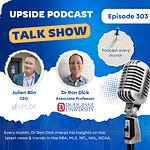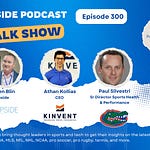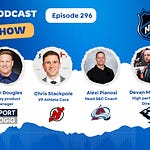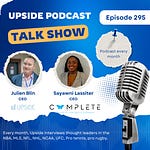This week we interviewed Vien Vu, a collegiate physical therapist.
📝Show Notes: Through this interview with Vien, we touched on his background in college sports. Then we discussed his role at a collegiate physical therapist, his experience using KINVENT and why he chose to adopt KINVENT products. We also touched on the importance of technologies.
Best Quotes: Here’s some of the key discussion points and best quotes from our conversation with Vien:
On his background:
“ I did an undergraduate in kinesiology or exercise science at San Jose State University in California. And then I started my career as a personal trainer. And honestly, I did not know what a physiotherapist was. The other side too is a lot of people would come to me and say like, Hey, I have this new pain going on. Can you help me? Or what should I do? And I didn't feel confident answering that, so I became a physical therapist and went to school for that”.
“I still don't have all the answers, but I just feel more confident in looking for the answers, and that's what I found out with the process. So after that I went to PT school at University of Pacific in Stockton, CA. I did a sports residency in physiotherapy at Gunderson in Wisconsin. And then after that I did a year of fellowship at Wake Forest University in North Carolina. And then I worked a little bit in Oregon and now I am one of five physical therapists at Stanford University”.
On his role as a collegiate physical therapist and the types of teams / athletes he works with:
My director, Tammy Moreno, had integrated us into a different system called pods. So basically, five physical therapists are in pods. And what pods are is basically whatever teams we're with”.
“So if I'm seeing one sport that has an athletic trainer, I'm probably going to see his or her other sports as well. And then the physician also assigns those sports in that pod as well as a strength coach. So I see athletes in track and field, the women and men swimming team, the diving team, and women's tennis players. I also see athletes in field hockey. And I see a little bit of athletes in American football. And I think those are my main teams (…) I try to make it out to the practices at least once a week for each of the teams”.
On when and how he has been using KINVENT at Stanford with his athletes:
“KINVENT has a host of products like force plates, nanometers, and basically all of their devices measure the force. Each device might give different outputs and you can perform different ones. So you have to choose the right device on what tests you want to do”.
“Basically I use KINVENT devices for mainly to monitor certain impairments or throughout or during the return of sports testing, when they're ready to run again or when they might be ready to cut or go back to full go. Then I'll use it then”.
On the benefits of using KINVENT products such as their single app to control all devices:
“For a protocol, if I use the force plates first and then the dynamometer, all that would function from one app on my device”.
“KINVENT gives you another way to look at data. So all these devices exist out there, but one nice thing about KINVENT is it's all centralized. So again, the force plate data goes to the same app as the dynamometer”.
So it's just easier to see it. Currently I use the mobile app just because there's a few more metrics I can use. I've already been using other devices to measure, but using the KINVENT products just makes my process a little bit faster”.
On the fact that he likes KINVENT’s hardware, attractive pricing, data visualization, centralized approach, and team’s reactivity to take his feedback, with software updates every 3 weeks:
“I personally like KINVENT just because the hardware is actually very impressive. The price point is very good for what you get. And again everything is centralized. It's easy to use and the biggest thing is the visualization of it on the app. So it's just easier to read for my patients. I can show them, I can navigate it a little bit easier”.
“And then the other part is really the engineers (…) I'm just a clinician, so I couldn't even fathom the things their engineers invented or did with their devices. And just seeing how fast they update their products is impressive”.
“The KINVENT team sends out a software update every three weeks and they really take in feedback and that's why I like it it so far because anytime I have an issue with it, they usually fix it pretty quickly. But right now I think the main reason I like KINVENT is just the quality of the devices and then how easy it's to the visualizations of the actual software itself make it really appealing to me and my patients”.
On the importance of technologies for him as a physical therapist:
“It's super important to me. A lot of people think they can measure things by hand and everything, but to me, I can't sense if a muscle is not activated or weak or something like that if I didn't even measure it. So I personally like being very objective and having a metric for that, whether it be range of motion or strength”.
“If I can measure it and then if it looks good, then I won't really treat it. I can leave it as is and work on the things that they need to work on. So I feel like from a liability standpoint for releasing patients back to sport, it's a safety issue. And then from a treatment standpoint, it makes my treatment work concise. I know exactly what I need to do, and then also my treatments are more effective. If I don't see changes, then I have to switch my treatments in order to make the right improvement”.
On the state of the rehab space:
“I don't think that the rehab space is growing faster than the performance space necessarily because I think that we're behind the performance space. I think that the performance space has been looking at all this for years already”.
“The good side though is, again, budgeting and finance is a huge issue. And as time goes on, technologies are becoming cheaper and cheaper and the capabilities get better and better. So I think now that it's getting so much cheaper and more accessible for rehab people like myself”.
“And then there is more research looking into the rehab population.
So before we'd have these devices, but we didn't know what to look for, how to use it in rehab. Now that the research is getting published in that direction, then we have a better reason to use these technologies”.
You may also like:
🔥 Upside Chat: Dave Hancock, CEO, Apollo (Leading Athlete Management Systems (AMS) vendor)
🔥 Upside Chat: Dr Andy Barr, Consultant, Brooklyn Nets (NBA) & Quantum Performance Founder











